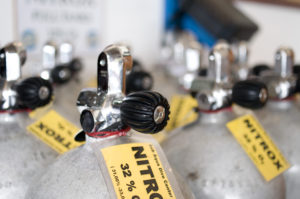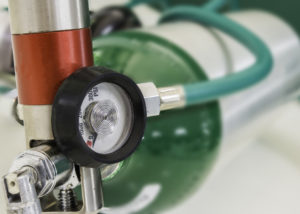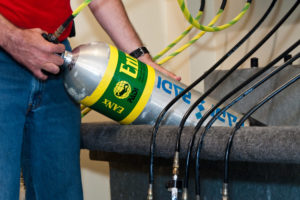If you’re a true diving addict, it doesn’t take long to start feeling water withdrawals during the winter months. Living somewhere cold can leave you wondering how to stay active during the offseason. Aside from flying south or enrolling in an ice-diving or drysuit course, you can sign up for several non-diving specialty classes. Stay active with these off-season scuba classes when local dive conditions don’t allow the urge to submerge.
 Enriched Air Diver (Nitrox)
Enriched Air Diver (Nitrox)
Most agencies do not require in-water dives for the nitrox class, as all learning takes place on land. You can even complete most lessons online with programs such as PADI’s or TDI’s Enriched Air online. In the Enriched Air Diver course, you will learn how diving with enriched-air gas mixtures (oxygen content between 22 and 40 percent) can significantly increase your bottom times and no-decompression limits. Though there are trade-offs when using enriched air, such as shallower depth limits and the risk of oxygen toxicity if you go too deep, the course addresses these concerns. The benefits far outweigh the risks.
For example, on the PADI enriched air tables, a first dive of the day to 100 feet (30 m) using a mix of EANx32 allows a maximum bottom time of 30 minutes. You would only get 20 minutes if diving regular air. This means a 50 percent increase in no-deco time. When conducting multiple dives, the repetitive dive time also grows significantly compared to repetitive diving on air. When it’s time to hit the water again in the spring, you’ll maximize your in-water time with a nitrox course.
PADI prerequisites: Open Water Diver/12 years old/class time approximately six hours
Equipment Specialist
You needn’t be a dive pro to reap the benefits of this class. While the PADI Equipment Specialist course is not a manufacturer’s technical-servicing class, you will learn how to take care of equipment so it lasts longer. You’ll also learn how to properly store and transport equipment to prevent damaging hoses and valves. The course also covers basic trouble-shooting, such as changing O-rings on a high-pressure SPG or changing out a corrugated inflator hose on a BCD.
You’ll learn how to clean out stuck or leaking dump valves on a BCD and how to clean the inside of a second stage. You’ll learn how to swap out or reseat displaced diaphragms. Save time and money (and your dive) by learning how to change your own mouthpieces on second stages and fix fin straps. This can be a great opportunity to give your dive gear the once-over when you take it out of winter storage.
PADI prerequisites: Junior Scuba Diver/10 years old
 Emergency Oxygen Provider
Emergency Oxygen Provider
Emergency Oxygen Provider is a fun course that will boost your confidence when it comes to the function and oxygen-delivery options of a modern scuba O2 kit. You’ll learn to recognize signs and symptoms of DCS and how to assemble the O2 kit. You’ll also learn how to deliver oxygen to both breathing and non-breathing divers. Using the non-rebreather mask, demand valve and positive-pressure valve for one or two divers simultaneously are skills that all divers should have. Use this winter to become not just an active diver in the spring, but a prepared diver as well.
Non-diver/No minimum age/approximately three hours
Project Aware Specialist
Every day we read more about climate change and threats to the oceans and aquatic life. There are two PADI Project AWARE non-diving specialty classes, Project AWARE Specialist and Project AWARE Coral Reef Conservation. Both aim to educate students about different threats to the aquatic environment on global and local levels, also focusing on areas where there are coral reefs. These courses are interesting, fun, informative and a must for all divers, snorkelers and non-divers who want to learn more about how they can make positive changes for the aquatic world, even when they’re not diving.
Non-diver/No minimum age/approximately four hours
 Technical Diving Tec Gas Blender
Technical Diving Tec Gas Blender
(ideal for dive professionals)
The PADI Technical Diving Tec Gas Blender class is ideal for dive professionals. Even divemasters and instructors may go a few months out of the water. This is the perfect opportunity for pros to take continuing-education classes with real benefit. Gas Blending is a great non-diving specialty that teaches students how to make enriched air and trimix gas blends. The PADI/DSAT Gas Blender specialty also covers O2 cleaning. This course improves knowledge and skills and increases a dive professional’s versatility around a dive center. It also improves their employability and possibly earnings potential.
PADI Enriched Air Diver/18 years old/approximately eight to 10 hours.
Buoyancy Refresher or Fundamentals Clinic
Although this is not a formal specialty class or course, divers who aren’t confident with their buoyancy skills after an absence from the water should get a pool refresher before diving again. Visit your local dive center and find an instructor who can conduct a buoyancy clinic. If necessary, also refresh specific dive skills, such as mask removal and replacement or alternate air-source use. Divers who feel confident with their buoyancy and general dive skills can still advance their technique in the water with a pool session on buoyancy and trim fundamentals and fin-propulsion techniques under the guidance of an experienced instructor.
Although you may not be able to get in the water during the winter, sign up for a few of these off-season scuba classes. Before you know it the ice will have melted. You’ll be more knowledgeable and skillful when you do splash in, no matter where you go diving.




